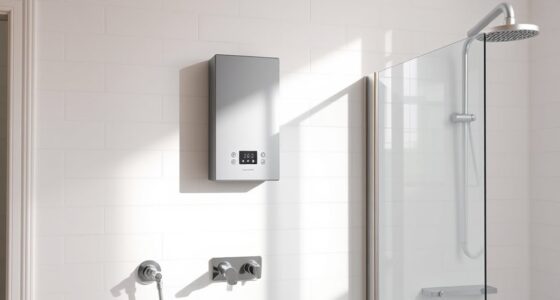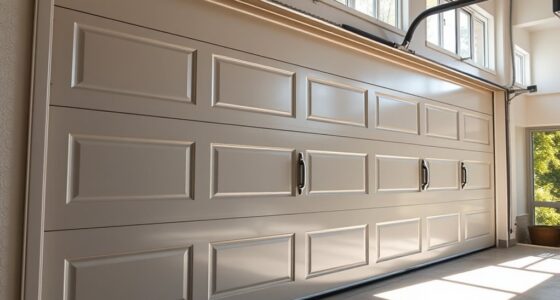If you’re choosing between slatwall and pegboard for garage storage, consider your needs. Slatwall offers a sleek, heavy-duty option with versatile accessories, perfect for bulky tools and long-term organization. Pegboard is more budget-friendly and easy to reconfigure for lighter items. Both systems improve space, but understanding their features helps you select the best fit. Keep exploring to find out which system aligns with your garage setup and storage goals.
Key Takeaways
- Slatwall offers higher load capacity and durability, ideal for heavy tools and power equipment.
- Pegboard is more affordable, easier to install, and flexible for lightweight tools and quick reconfiguration.
- Slatwall supports a wide range of accessories, providing a sleek, customizable storage solution.
- Pegboard allows for quick access and visibility, suitable for organizing small tools and supplies.
- Proper installation is crucial for both systems to ensure safety, stability, and optimal storage performance.

Organizing your garage efficiently often starts with the right wall storage system. Choosing between slatwall and pegboard can considerably impact how you utilize space and access your tools. Both options are popular for their ability to maximize vertical space, but they serve different needs and preferences. Understanding their features and benefits helps you decide which fits your garage best. Slatwall consists of horizontal slats that allow for versatile mounting options. You can attach hooks, bins, racks, and shelves directly to the slats, creating a customizable storage configuration. This system offers a clean, finished look that enhances your garage’s appearance. Made from durable materials like MDF with vinyl or laminate finishes, slatwall panels resist moisture and support heavy loads, making them ideal for storing power tools, sports gear, or bulky equipment. Installing slatwall involves mounting panels securely to wall studs to ensure stability and strength. Because it supports a wide range of accessories, it offers high modularity, letting you adapt your storage as your needs evolve. Additionally, biodiversity can be promoted through organized outdoor spaces, emphasizing the importance of a clutter-free environment that supports local ecosystems. Pegboard, on the other hand, features a grid of evenly spaced holes designed for inserting hooks and pegs. It’s typically made from metal, wood, or hardboard, with many options coated or painted for durability and moisture resistance. Pegboard is known for its flexibility; you can quickly reconfigure your layout by changing hook positions, making it perfect for light to medium-weight tools and accessories. It’s often easier and more affordable to install than slatwall, as it simply attaches to the wall with hooks or mounting hardware. However, because of its lighter construction, pegboard may require reinforcement if you want to hang heavier items. It provides excellent access and visibility for small tools, hand tools, and supplies, making it a practical choice for quick-access storage. When comparing load capacity and durability, slatwall generally supports heavier objects due to its solid panel design and robust mounting methods. It’s better suited for bulkier equipment and power tools. Pegboard, while flexible and easy to adapt, typically supports lighter loads unless reinforced. Materials also matter: slatwall’s composite construction offers better moisture resistance, increasing longevity in damp garages. Both systems rely heavily on proper installation; improper mounting can compromise their load capacity and stability. Some premium pegboards made of metal can handle higher weights and offer increased durability. In terms of customization, slatwall accommodates a vast array of accessories, including specialized racks, baskets, and shelves, providing high modularity. Pegboard supports various hooks and small containers but may have fewer options for specialized accessories. Your choice depends on your storage needs, budget, and garage environment. If you require heavy-duty, long-lasting storage with a sleek appearance, slatwall is a strong choice. For budget-friendly, flexible, and easy-to-reconfigure storage, pegboard works well. Both systems, when installed properly, can transform your garage into an organized, accessible space that makes your tools and equipment easy to find and use.
Frequently Asked Questions
Which System Is More Cost-Effective Long-Term?
You’re wondering which system saves you money over time. While pegboard costs less upfront, slatwall’s durability and stronger materials mean fewer replacements and repairs down the line. Slatwall can handle heavier loads and resists wear better, reducing maintenance costs. Although initially pricier, its long-term benefits include lower upkeep and added aesthetic value, making it a more cost-effective choice for lasting garage organization.
Can Both Systems Be Used Together Effectively?
You might wonder if combining systems is worth the effort, but it’s actually a smart move. While one offers heavy-duty support, the other excels at organizing small tools. Using both together balances strength and precision, maximizing your garage’s storage potential. Proper mounting and planning guarantee they work seamlessly side by side. This combination boosts efficiency, keeps clutter down, and makes tool retrieval faster—ultimately giving you a tailored, versatile organization solution.
How Easy Is It to Install Each System?
You’ll find that installing a pegboard is generally easier and quicker, requiring fewer tools like saws and shims. You just locate studs, mark them, and screw the board in place. Slatwall installation is more involved; it needs precise measurements, panel acclimation, and additional tools for cutting. Expect it to take more time, but it offers greater durability and design flexibility once installed properly.
Are There Weight Limits for Items on Slatwall and Pegboard?
Imagine hanging your favorite tools, each one perfectly supported, yet knowing there’s a limit. You ought to keep in mind that both slatwall and pegboard have weight restrictions—slatwall panels can hold up to 300 pounds per panel, while brackets support around 12 to 50 pounds. Pegboards generally support lighter loads, so avoid overloading to prevent damage. Always check specific weight ratings to ensure your items stay secure and safe.
Which System Offers Better Customization Options?
When choosing a storage system, you want one that offers great customization options. Slatwall provides more flexibility with its reconfigurable slotted design, allowing you to swap accessories easily and create custom solutions. It supports a wide variety of finishes and accessories, making it ideal for a modern, adaptable look. Pegboard offers excellent accessory availability but is more limited in customization, especially for unique or tailored solutions.
Conclusion
Choosing between slatwall and pegboard might seem small, but it can transform your garage into a space you love. Imagine finding that perfect hook just when you need it, or your tools neatly displayed after years of clutter. Sometimes, the right organization system appears just when you least expect it, making everything feel effortlessly in place. Trust your instincts—you’re about to create a garage that’s as functional as it is inspiring.









